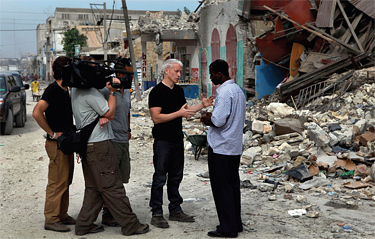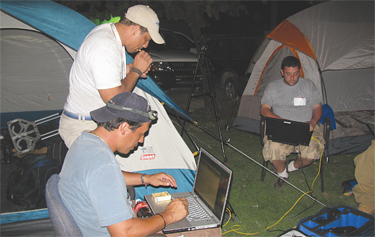Haiti Coverage Tests News Crews

CNN’s Anderson Cooper in Port-au-Prince, Haiti. Jonathan Torgovnik/Reportage for CNN
PORT-AU-PRINCE, HAITI
When a 7.0 earthquake struck about 15 miles southwest of Haiti's capitol at 4:53 p.m. on Jan. 12, it destroyed the country's communications infrastructure.
News broadcasters worldwide scrambled to gather their crews, charter transportation, contact aid agencies and point persons in Port-au-Prince and in Santo Domingo, the capital of the Dominican Republic, which abuts Haiti's eastern border.
At 9:40 p.m. that same night, Reuters Television broadcast a live feed from local cameraman Jean Valme: dramatic footage of the injured and dying and their collapsed homes.
"Jean had been driving on the outskirts of town when the quake hit," said RT's Global Editor John Clarke. "He grabbed his camera, shot the video, quickly turned it into a video file on his laptop computer, and found an Internet connection to feed the material to London."
The following day, Reuters videojournalist Ben Gruber delivered footage of arriving relief planes and a growing refugee camp after setting up a profes-sional satellite dish at the Port-au-Prince airport.
That same morning, Jan. 13, Anderson Cooper phoned in CNN's first report from Haiti. CNN's first live video report was transmitted at mid-afternoon by reporter Susan Candiotti using an Inmarsat Broadband Global Area Network (BGAN) terminal uplinked to Intelsat's Horizons 2 bird. CBS transmitted its first on-site report for the "CBS Evening News" via Intelsat 9 using a Norsat terminal rented from its operator, a freelance engineer named Roger Hawkins.
Intelsat noted that within hours of the quake it established two communications networks—one in C-band and one in Ku-band—to provide critical commu-nication links.
News teams pooled their resources to reach the hard-to-come-by signals. For example, "NBC Nightly News" confirmed that Brian Williams anchored its first Haiti broadcast from Reuters' news dish about 10 minutes into the show after NBC's generator blew out.
BECOMING THE STORY
"Everybody has a job to do, but to see the devastation, and what the people have been through, and the unsightly things that we've shown on the evening news has an emotional impact," said Frank Governale, vice president of CBS News. "It takes a lot out of you when you do a story like this."
News team members literally became part of the rescue effort.
Quick International Carrier, chartered by both the Red Cross and CBS, enlisted a "60 Minutes" crew in its efforts to deliver blood to Haiti. After a 30-minute delay stateside to collect the cargo, the plane was detoured to Santo Domingo. CBS chartered a second plane to Port-au-Prince, where it delivered the blood to United Nations personnel. According to the Red Cross website, the U.N. staff delivered the blood to a hospital, where "staff started using it almost immediately."
Medical correspondents for ABC, CBS, CNN and NBC also offered their services to care for patients. ABC's Dr. Richard Besser facilitated the transfer of a woman in labor from a park to an Israeli-run field hospital. NBC's Dr. Nancy Snyderman attended the wounded in a makeshift trauma center. CNN's Dr. Sanjay Gupta performed emergency surgery on a 12-year old girl with a skull fracture who had been airlifted to the aircraft carrier Carl Vinson.
"Injuries were a major part of the story, so it made sense—CBS management endorsed that," said Governale. He noted that CBS' Dr. Jennifer Ashton "was ac-tually doing triage."
When questioned about the integrity of simultaneously reporting on a disaster and becoming the story itself as part of a medical team, CNN's Gupta said press credentials should not preclude helping people in life and death situations.
"You could do both," he said. "And both have value."
LOGISTICS

Reuters Television video journalists, Alberto Fajardo (front), Jesus Frias (standing) and Ben Gruber (back) at Port-au-Prince airport Prior to the earthquake, broadcasters' presence in Haiti was limited to a few stringers.
In the aftermath, CBS' team swelled to "more than a couple of dozen," said Governale. CNN had as many as 60 people, according to Parisa Khosravi, CNN Worldwide's senior vice president for all international newsgathering. By her assessment, CNN still had four teams (about 30 people) in Haiti at the beginning of February.
It was a huge task to get personnel into the country and set up conditions so that they didn't have to worry about basic needs and could focus on cover-age.
"We were constantly checking with them to see how they were doing—we put in rotations very quickly," said CNN's Khosravi. "To see devastation, misery and tragedy like that can really impact people."
There was no power or running water; the airport had no traffic control; roads and the port were jammed. Broadcasters chartered private planes, helicop-ters, and cars for personnel. Supply convoys from Santo Domingo were set up by the second day to provide food, water, first aid kits, mosquito netting, air mat-tresses, sleeping bags, fuel and equipment. In at least one case, a truck was used as a storage facility. Security forces were hired. CNN provided counseling serv-ices for those needing to vent their qualms.
Local telecommunications was nonexistent, so broadcasters relied on ingenuity, BGAN units, Iridium handsets and the best satellite paths possible for all transmission and communication.
CBS News, for example, started with a Norsat uplink to Intelsat 9 using a DC-AC inverter running off a car battery. It soon had a generator and use of its own CML antenna system linked to Intelsat's Galaxy 25, which provided a direct link to New York and a return path to Haiti. The third uplink, a QuickSPOT system rented from Foothill Ranch, Calif.-based On Call Communications, provided a video path, T-1 quality bandwidth, and up to 24 telephone lines.
Reuters transmitted live from satellite phones all over the city, as well as from its satellite dish at the airport, said Clarke.
"Transmission switched between two BGAN lives, one that went direct to London, and another which came to Washington DC and was passed on to London via fiber," he said.
Get the TV Tech Newsletter
The professional video industry's #1 source for news, trends and product and tech information. Sign up below.
